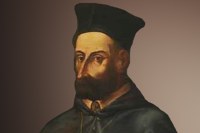The first layman to teach Canon Law at the University of Bologna, Egidio Foscherari made his fortune through his profession as a teacher and town councillor during the difficult years of the clashes between the Guelphs and Ghibellines. His tomb in the town square of San Domenico still bears witness to his status.
 Egidio Foscherari was born in the first decades of the 13th century to an old Bolognese family of bankers and politicians siding with the Guelphs.
Egidio Foscherari was born in the first decades of the 13th century to an old Bolognese family of bankers and politicians siding with the Guelphs.
Historiography is still debating whether to consider him another ‘magister Aegidius', whose works can be dated to around the same period of activity.
From his most important work, De ordine iudiciorum (written between 1260 and 1266), it may be inferred that he had a special relationship with Berengario da Parma, often referred to by the author as 'dominus et magister', probably due to his being his master of Canon Law.
After obtaining his degree, Foscherari too taught Canon Law, despite his secular status, and had numerous students, including Giovanni d'Andrea.
In 1279, he fell ill and was replaced in his teaching role by the Spaniard Garzia, later resuming his role, as evidenced by teaching-related documents dated later.
Together with many of his colleagues, he was also active in the city’s public life, which at that time was shaken by the constant internal wars between the Ghibelline Lambertazzi and the Guelph Geremei.
Such prominent activities led him to become an illustrious and powerful figure, and the owner of town houses, lands, vineyards and farms in the countryside. This also entailed excellent marriage contracts, no less than three, which saw him tie himself to other important local families, such as the Pepoli (on his third marriage, he tied himself to Gisela, daughter of the powerful Giovanni Pepoli).
At his sumptuous funeral in 1289, canonists were allowed to wear scarlet, a colour until then reserved only for knights and jurists.
His beautiful funeral monument, one of the five surviving ones in the city, can still be admired today. It overlooks Piazza San Domenico, a church designated by the University of Bologna for the assemblies of Italian jurists. This is the only funeral monument dedicated to a canonist glossator. More understated than others, it reuses parts of pre-existing buildings, such as a beautiful fragment of a Carolingian ciborium with peacocks.
In the very central Via Marchesana, what remains of the family tower still reminds us of the prestige achieved by the Foscherari family, whose name a neighbouring street still bears: an entire district where their houses stood and near which, three centuries after Egidio's death, the Archiginnasio of the Alma Mater Studiorum was to be created.
